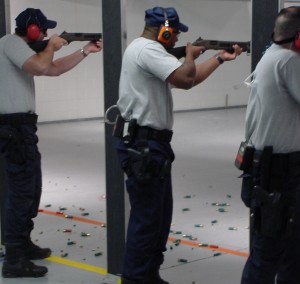Take Aim at Protecting Yourself
Posted on bySolutions for Preventing Lead Poisoning and Hearing Loss at Indoor Firing Ranges
 If you work or train regularly at indoor firing ranges, you could be exposed to hazardous levels of lead and noise. An estimated 16,000–18,000 indoor firing ranges operate in the United States. Some do not have sufficient environmental and occupational health controls in place to effectively protect the health of shooters and firing range personnel from exposure to lead (from lead bullets and cartridge primers), noise, and other contaminants. Those at risk include thousands of employees at indoor firing ranges, more than a million Federal, State, and local law officers who are required to train regularly at these facilities, and 20 million active target shooters.
If you work or train regularly at indoor firing ranges, you could be exposed to hazardous levels of lead and noise. An estimated 16,000–18,000 indoor firing ranges operate in the United States. Some do not have sufficient environmental and occupational health controls in place to effectively protect the health of shooters and firing range personnel from exposure to lead (from lead bullets and cartridge primers), noise, and other contaminants. Those at risk include thousands of employees at indoor firing ranges, more than a million Federal, State, and local law officers who are required to train regularly at these facilities, and 20 million active target shooters.
NIOSH recently issued a new Alert, Preventing Occupational Exposures to Lead and Noise at Indoor Firing Ranges. The Alert presents five case reports that document lead and noise exposures and examines firing range operations, exposure assessment and control methods, existing regulations, and exposure standards and guidelines.
Lead exposure
Numerous factors and routes of exposure can contribute to workers’ and patrons’ exposures to lead at indoor firing ranges. Environmental factors include the type of ventilation system used at the firing range, the types of ammunition used, and the length of time that shooting occurs. Exposure risk factors include the type and frequency of work practices conducted at the range, particularly those involving cleaning the firing range and other maintenance activities. At indoor firing ranges, lead dust from firearms discharge can be inhaled or contaminate surfaces and then transferred to people’s skin, especially the hands. Lead from the hands can be ingested while handling food, beverages, and other items that contact the mouth. Elevated blood lead levels can lead to lead poisoning. Symptoms of lead poisoning include the following:
- Nausea
- Diarrhea
- Vomiting
- Poor appetite
- Weight loss
- Anemia
- Excessive lethargy or hyperactivity
- Headaches
- Abdominal pain
- Kidney problems
In addition, lead poisoning, neurological effects, and mental retardation have occurred in children of workers who bring lead home on their clothes, skin, or other surfaces.
In one case study of law enforcement trainees described in the Alert, blood lead levels at an indoor firing range rose from a pre-training mean of 6.5 µg/dL to 50.4 µg/dL post training. Mean airborne lead concentrations were more than 40 times the OSHA permissible exposure limit. After changes were made to the ventilation system, airborne lead concentrations dropped to below detectable levels. In addition, using ammunition that had nylon-coated and copper-jacketed bullets substantially reduced (94% to 97%) airborne lead concentrations.
Detailed recommendations for employers and workers are available in the Alert. Controlling exposures to occupational hazards is the fundamental method of protecting workers. Traditionally, NIOSH uses a hierarchy of controls to reduce or eliminate workplace hazards:
- Elimination of the hazard
- Substitution of a less hazardous material
- Engineering controls
- Administrative controls (to reduce time of exposure)
- Personal protective equipment
Proper ventilation, good housekeeping practices, and basic personal hygiene practices will limit or eliminate the risk of lead exposure. Examples of NIOSH recommendations for workers include the following:
- Wear respirators and full protective outer clothing when performing range maintenance.
- Wear gloves and eye protection when using chemicals to clean weapons or firing range surfaces.
- Wash hands, forearms, and face before eating, drinking, smoking, or contact with other people.
- Change clothes and shoes before leaving the firing range facilities.
- Wash clothes or uniforms used at the firing range separately from family’s clothing.
Noise exposure
The discharge of firearms in an indoor firing range produces peak noise levels that exceed the occupational health limits of 140 dB SPL. NIOSH recommends that workers and shooters who use a firing range as part of their occupation (i.e, law enforcement officers) wear double hearing protection (earplugs and earmuffs) as part of an overall hearing conservation program. Special attention must be paid to the use of safety glasses under earmuffs so not to create an acoustical leak and degrade the performance of the hearing protectors.
Exposure to high levels of noise can lead to the following:
- Hearing loss
- Tinnitus (ringing in the ear, which might be permanent)
- Stress
- Anxiety
- High blood pressure
- Gastro-intestinal problems
- Chronic fatigue
NIOSH would like to hear from you regarding your experiences working or training at indoor firing ranges. What prevention methods do you or your employer take? What has worked? What has not worked? Would you be interested in receiving more information or review other products from NIOSH on indoor firing ranges? More information is available in the NIOSH Alert and on the NIOSH Indoor Firing Ranges topic page.
Mr. Kardous is a research engineer in the NIOSH Division of Applied Research and Technology.
Posted on by

